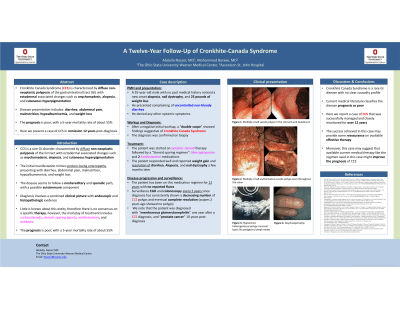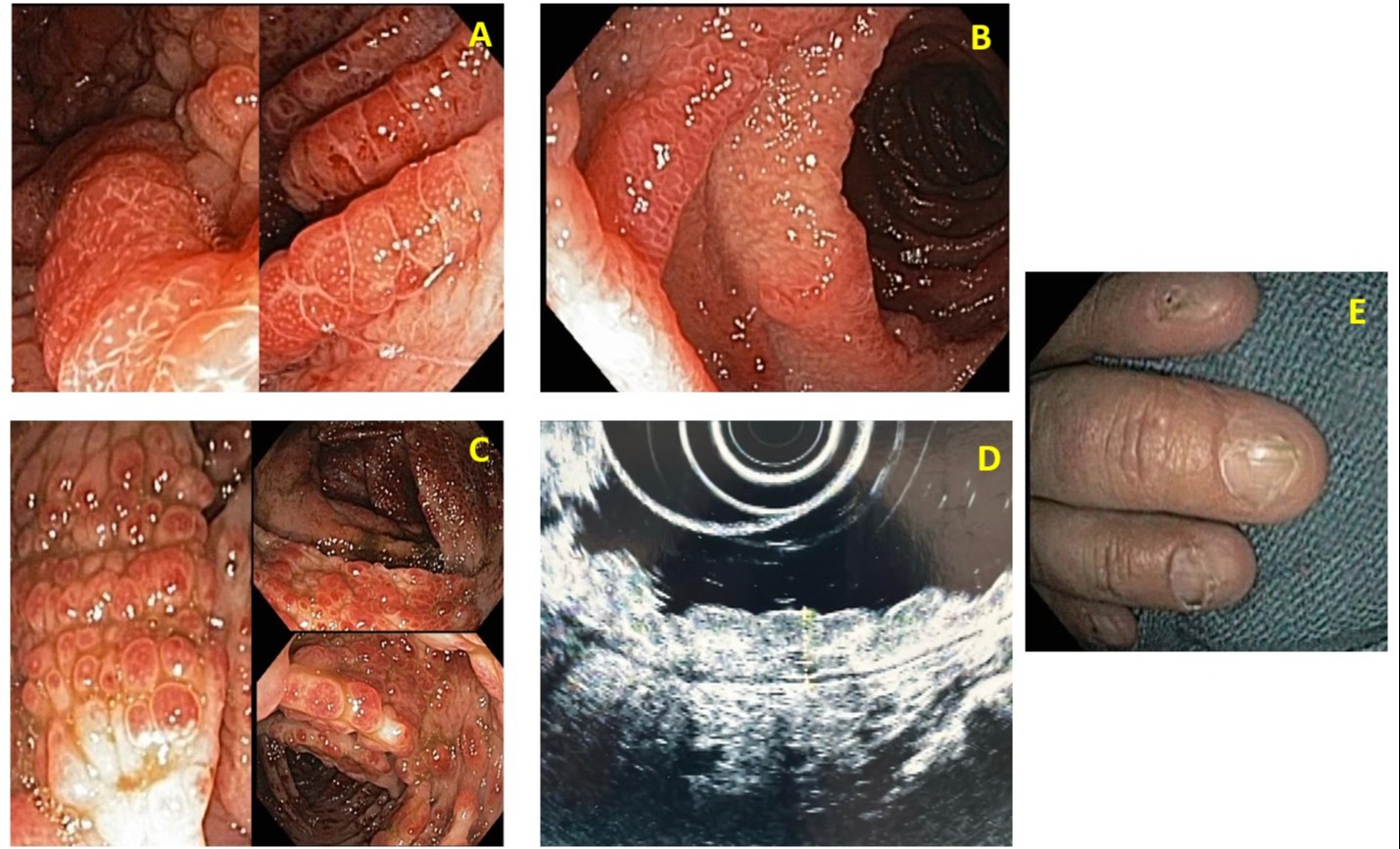Monday Poster Session
Category: General Endoscopy
P1991 - A Twelve-Year Follow-Up of Cronkhite-Canada Syndrome
Monday, October 23, 2023
10:30 AM - 4:15 PM PT
Location: Exhibit Hall

Has Audio

Abdulla Nasser, MD
The Ohio State University Wexner Medical Center
Dearborn Heights, MI
Presenting Author(s)
Abdulla Nasser, MD1, Mohammed Barawi, MD2
1The Ohio State University Wexner Medical Center, Dearborn Heights, MI; 2Ascension St. John Hospital, Detroit, MI
Introduction: Cronkhite Canada Syndrome (CCS) is a rare gastrointestinal (GI) disorder characterized by diffuse non-neoplastic polyposis of the GI tract with ectodermal associated changes such as onychomadesis, alopecia, and cutaneous hyperpigmentation. The initial manifestation mimics protein-losing enteropathy, presenting with diarrhea, abdominal pain, malnutrition, hypoalbuminemia, and weight loss. The disease seems to follow a nonhereditary and sporadic path, with a possible autoimmune component. Diagnosis involves a combined clinical picture with endoscopic and histopathologic evidence. The mainstay of treatment includes corticosteroids, steroid-sparing agents, antihistamine therapy, and antibiotic. The prognosis is poor, with a 5-year mortality rate of about 55%. Here we present a case of CCS in remission 12 years post-diagnosis.
Case Description/Methods: A 55-year-old male with no past medical history noticed some new onset alopecia, nail dystrophy, and a 25 pounds weight loss, and presented to the hospital with the chief complaint of uncontrolled non-bloody diarrhea. He denied any other systemic symptoms. After a negative initial workup, the patient was seen by GI who performed a “double scope” that showed findings suggestive of CCS, later confirmed on biopsy.
The patient was started on systemic steroid therapy followed by a “Steroid sparing regimen” (Mercaptopurine and 2 antihistamine medications). The patient responded well and reported weight gain and resolution of diarrhea, Alopecia, and nail dystrophy a few months later. The patient has been on this medication regimen for 12 years with no reported flares. Surveillance EGD and colonoscopy every 2 years since diagnosis has consistently shown a decreasing number of CCS polyps and eventual cocomplete resolution. The last scopes 2 years ago showed no polyps. We note that the patient was diagnosed with “membranous glomerulonephritis” one year after a CCS diagnosis, and “prostate cancer” 10 years post-diagnosis. Here we report a case of CCS 12 years in remission with close monitoring.
Discussion: CCS is a rare GI disease with no clear causality profile. Current medical literature classifies the disease prognosis as poor. Here we report a case of CCS that was successfully managed and closely monitored for over 12 years. The success achieved in this case may provide some reassurance on available effective therapy. Moreover, this case may suggest that available current medical therapy like the regimen used in this case might improve the prognosis of CCS

Disclosures:
Abdulla Nasser, MD1, Mohammed Barawi, MD2. P1991 - A Twelve-Year Follow-Up of Cronkhite-Canada Syndrome, ACG 2023 Annual Scientific Meeting Abstracts. Vancouver, BC, Canada: American College of Gastroenterology.
1The Ohio State University Wexner Medical Center, Dearborn Heights, MI; 2Ascension St. John Hospital, Detroit, MI
Introduction: Cronkhite Canada Syndrome (CCS) is a rare gastrointestinal (GI) disorder characterized by diffuse non-neoplastic polyposis of the GI tract with ectodermal associated changes such as onychomadesis, alopecia, and cutaneous hyperpigmentation. The initial manifestation mimics protein-losing enteropathy, presenting with diarrhea, abdominal pain, malnutrition, hypoalbuminemia, and weight loss. The disease seems to follow a nonhereditary and sporadic path, with a possible autoimmune component. Diagnosis involves a combined clinical picture with endoscopic and histopathologic evidence. The mainstay of treatment includes corticosteroids, steroid-sparing agents, antihistamine therapy, and antibiotic. The prognosis is poor, with a 5-year mortality rate of about 55%. Here we present a case of CCS in remission 12 years post-diagnosis.
Case Description/Methods: A 55-year-old male with no past medical history noticed some new onset alopecia, nail dystrophy, and a 25 pounds weight loss, and presented to the hospital with the chief complaint of uncontrolled non-bloody diarrhea. He denied any other systemic symptoms. After a negative initial workup, the patient was seen by GI who performed a “double scope” that showed findings suggestive of CCS, later confirmed on biopsy.
The patient was started on systemic steroid therapy followed by a “Steroid sparing regimen” (Mercaptopurine and 2 antihistamine medications). The patient responded well and reported weight gain and resolution of diarrhea, Alopecia, and nail dystrophy a few months later. The patient has been on this medication regimen for 12 years with no reported flares. Surveillance EGD and colonoscopy every 2 years since diagnosis has consistently shown a decreasing number of CCS polyps and eventual cocomplete resolution. The last scopes 2 years ago showed no polyps. We note that the patient was diagnosed with “membranous glomerulonephritis” one year after a CCS diagnosis, and “prostate cancer” 10 years post-diagnosis. Here we report a case of CCS 12 years in remission with close monitoring.
Discussion: CCS is a rare GI disease with no clear causality profile. Current medical literature classifies the disease prognosis as poor. Here we report a case of CCS that was successfully managed and closely monitored for over 12 years. The success achieved in this case may provide some reassurance on available effective therapy. Moreover, this case may suggest that available current medical therapy like the regimen used in this case might improve the prognosis of CCS

Figure: Figure 1: (A-B) Multiple small sessile polyps in the stomach and duodenum. (C) Multiple small erythematous sessile polyps were throughout the colon. (D) Hypoechoic heterogeneous polyps arising from the mucosal layer; No perigastric lymph nodes. (E)Onychodystrophy
Disclosures:
Abdulla Nasser indicated no relevant financial relationships.
Mohammed Barawi indicated no relevant financial relationships.
Abdulla Nasser, MD1, Mohammed Barawi, MD2. P1991 - A Twelve-Year Follow-Up of Cronkhite-Canada Syndrome, ACG 2023 Annual Scientific Meeting Abstracts. Vancouver, BC, Canada: American College of Gastroenterology.
